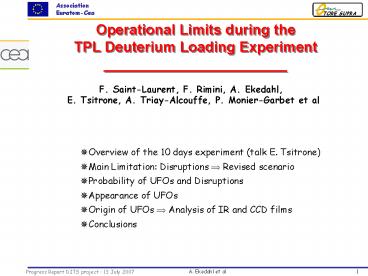Operational Limits during the TPL Deuterium Loading Experiment _______________________ - PowerPoint PPT Presentation
1 / 16
Title:
Operational Limits during the TPL Deuterium Loading Experiment _______________________
Description:
Overheating of co-deposited layers prior to disruption ... Then the tile remains overheated, but ne and Prad are recovered until the plasma ... – PowerPoint PPT presentation
Number of Views:110
Avg rating:3.0/5.0
Title: Operational Limits during the TPL Deuterium Loading Experiment _______________________
1
Operational Limits during the TPL Deuterium
Loading Experiment_______________________
F. Saint-Laurent, F. Rimini, A. Ekedahl, E.
Tsitrone, A. Triay-Alcouffe, P. Monier-Garbet et
al
- Overview of the 10 days experiment (talk E.
Tsitrone) - Main Limitation Disruptions ? Revised scenario
- Probability of UFOs and Disruptions
- Appearance of UFOs
- Origin of UFOs ? Analysis of IR and CCD films
- Conclusions
2
Performance evolution over 10 days
Scenario 1 Ip 0.6MA, PLH 2MW, 120 s pulse
duration
Scenario 2
Number of UFOs
Disruptions
Scenario 2 PLH reduced, 80 s duration
Day
F. Saint-Laurent, F. Rimini
3
Probability of UFOs and disruptions
Definition of UFO Increase in Prad gt 20
of UFOs per 100s of plasma of disruption per
100s of plasma
Disruption probability follows the number of
UFOs. ? 10-20 of UFOs lead to disruption
4
Appearance of UFOs Scenario 1
E. Tsitrone
5
Appearance of UFOs Scenario 1
LH power is switched off by the safety system
when UFOs appear
E. Tsitrone
01/06/07 (Day 7) lots of UFOs, and
disruptions. UFOs appear when PLH is first
applied, then more sporadic
6
Day 10 Search of power limit
E. Tsitrone
Reduced PLH No UFOs
Scenario 2 PLH limited to 1.6-1.8 MW
7
Time distribution of UFOs
24 shots with LH power
33 UFOs
Day 3
3 disruptions
117 UFOs
29 shots with LH power
Day 7
19 disruptions
8
IR analysis of disruptions
- IR cameras to monitor
- both LH launchers
- 1/6 of the TPL (Q6)
- 1/18 of the TPL with high resolution (Q5)
A. Ekedahl
Number of disruptions 62 Disruptions with IR
data available 59 1st origin Arcs in front of
launcher prior to disruption 18 30 Carbon
flakes from side protections prior to
arcing 10 2nd origin Hot spot on TPL prior to
disruption (Q6 and Q5) 14 Hot spot on TPL prior
to disruption (Q6 gt 1/6 of TPL) 10 17 Both
origins simultaneously 0
9
Disruption precursor Arcs
IR camera observation of LH launchers
Flaking of co-deposited layer from launcher side
protections ? Induce arcing in front of launchers
Increase of electron density and radiated
power
30 of the disruptions were preceded by arcs in
front of launchers. 70 of disruptions can NOT be
attributed to arcing.
LH launcher safety
- Impurity safety system detects Cu in the
plasma. - IR safety system detects arcing.
- LH power is switched off.
- Impurity safety system was later modified to act
on all impurities (C, Cu,Fe, ) to try to avoid
disruptions due to UFOs.
Plasma safety
10
Disruption precursor TPL
IR camera observation localized at vertical
port in Q6
Overheating of co-deposited layers prior to
disruption
Pulse 39918, t 4.16-4.34s
Localised hot spot on TPL appears around 4.0s.
Followed by overheating of the co-deposited
layer.
PRad and CIV increase at 4.2s. PLH is switched
off at 4.25s (plasma safety).
No arcs in front of launchers.
11
Disruption precursor TPL
Overheating of co-deposited layers prior to
disruption
39868, t6.4s
39868, t5.0s
39868, t6.0s
39868, t5.56s
Heating on high field side on TPL prior to
disruption
Overheating of TPL starts 100ms before increase
in PRad and ne . Increase in PRad is associated
with carbon release.
12
A MARFE is triggered before the disruption
P. Monier-Garbet
The ratio of the signals from two bolometer
sight-lines indicate the roll-over of the
radiation towards the HFS (MARFE)
bolo3/bolo14
0-100ms before LH is cut off
TS39868
Zeff-2
nl
PLH
b3/b14
steady phase
Ip
13
Appearance of UFO (IR camera)
Overheating of CFC tile on TPL gt UFO
Hot spot on TPL appears at 48.3s. ? Increase of
electron density and radiated power (UFO). Then
the tile remains overheated, but ne and Prad are
recovered until the plasma disrupts 50s later.
Q6A
39922, t 48.5s
14
Appearance of UFOs (visible CCD camera)
Localisation of UFOs from TPL for 2 days
1/3rd of TPL is observed
Origin Unknown 30 From TPL 70
A. Triay-Alcouffe
15
Conclusions
The TPL loading campaign was limited by
disruptions, induced by UFOs.
- Two strategies were applied
- Modified impurity safety system (fast switch-off
of LH power) - PLH reduced for all impurity influx (C, Cu, Fe,
) ? not enough. - Reduced PLH in beginning of pulse, followed by
slow PLH ramp-up - ? 80s pulse duration ? OK until end of campaign.
Day 4
Day 8
LH power limit 1.6 MW at the end of the
campaign.
- Statistical limit associated with the
probability of UFOs to appear. - 10-20 of the UFOs lead to disruption.
- - Dynamical limit the power threshold seemed to
decreased with time.
Analysis of CCD and IR films indicate that most
UFOs seem to originate from the TPL.
16
Appearance of UFOs
Data averaged over 5 shots
UFO Increase in Prad gt 20
Scenario 2
Scenario 1
Shot number
F. Rimini































